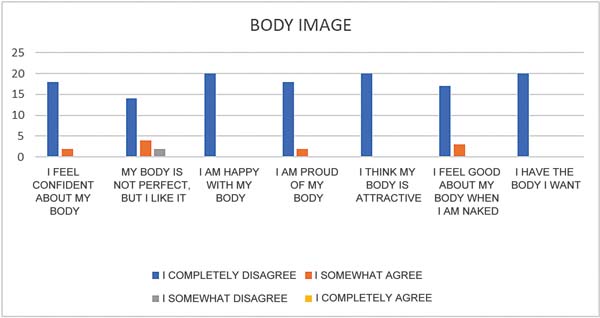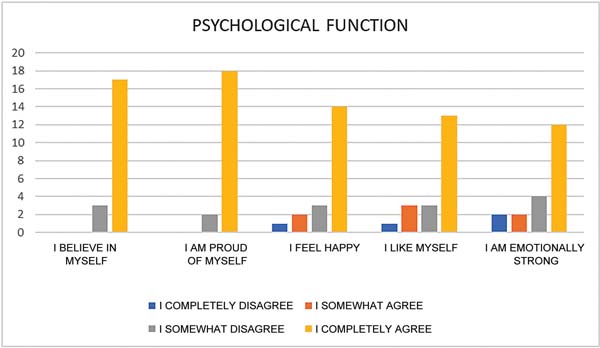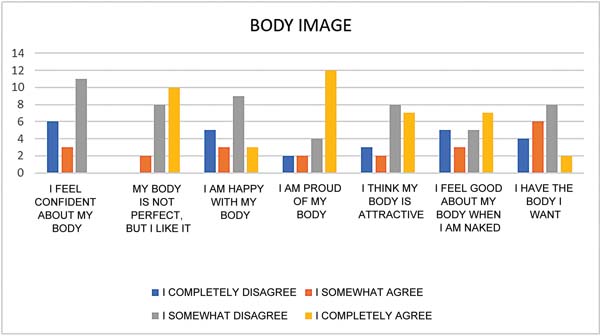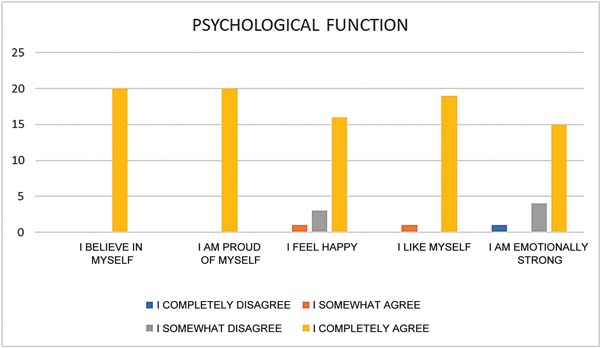

Original Article - Year 2025 - Volume 40Issue 1
Repercussion of Abdominoplasty on Interpersonal Relationships and Social Life of Patients at the Integrated Plastic Surgery Services, in São Paulo
Repercussão da abdominoplastia nos relacionamentos interpessoais e na vida social de pacientes dos Serviços Integrados de Cirurgia Plástica de São Paulo
ABSTRACT
Introduction The significant increase in overweight and obesity brings with it a greater number of patients who undergo aesthetic procedures, surgical or not, for better body contouring. In addition to physical and mental well-being, body care has a direct impact on social interaction.
Materials and Methods Using the BODY-Q questionnaire, patients' opinions about their bodies in the preand late postoperative periods, as well as the impact of body modification on their relationships were evaluated. We addressed questions about one's own body and social and sexual relationships. The questionnaire was administered in an outpatient setting after participants signed the informed consent form.
Results Important gains were noted in patients' perception of wellbeing in the postoperative period regarding their bodies and greater confidence in sexual relations. Differences in social relations were more subtle as there were no major social conflicts in the preoperative period.
Conclusion Abdominoplasty proved to be effective in positively transforming patients' relationships and wellbeing, impacting their self-esteem, social and professional circles, and intimate relationships.
Keywords: abdominoplasty; body image; psychological well-being; quality of life; self-image
RESUMO
Introdução O aumento expressivo de sobrepeso e obesidade traz consigo um maior número de pacientes que se submetem a procedimentos estéticos, cirúrgicos ou não, visando um melhor contorno corporal. Além do bem-estar físico e mental, o cuidado com o corpo tem um impacto direto nas interações sociais.
Materiais e Métodos Avaliou-se, por meio do BODY-Q, a opinião das pacientes sobre seus corpos no período pré- e pós-operatório tardio e o impacto da modificação corpórea em seus relacionamentos. Foramabordadas questões sobre avaliação sobre o próprio corpo, relações sociais e sexuais. O questionário foi aplicado em ambiente ambulatorial, após assinatura do termo de consentimento livre e esclarecido.
Resultados Notou-se ganhos importantes na percepção de bem-estar das pacientes no período pós-operatório em relação ao seu próprio corpo e maior confiança em relações sexuais. No quesito de relações sociais, as diferenças foram mais tênues tendo em vista que não havia grandes conflitos sociais no período pré-operatório.
Conclusão A abdominoplastia mostrou-se eficaz emtransformar de forma positiva os relacionamentos e o bem-estar dos pacientes, impactando em sua autoestima, círculo social e profissional, assim como em relacionamentos íntimos.
Palavras-chave: abdominoplastia; autoimagem; bem-estar psicológico; imagem corporal; qualidade de vida
Introduction
Abdominoplasty is a surgical procedure that resects skin and subcutaneous tissue of the infraumbilical region and plicates the aponeuroses of the rectus abdominis muscles through a low transverse incision. The goal of dermolipectomy is to reduce excessive skin, fat, and abdominal flaccidity to obtain a better regional contour and relief. The proper positioning of the transverse scar and its sides, the umbilical scar, and the pubic area results in a more harmonious outcome.1
The Brazilian Society of Plastic Surgery (Sociedade Brasileira de Cirurgia Plástica, in Portuguese) reported that dermolipectomy and liposuction are the second most performed plastic surgical procedures. Much of this demand results from the increased overweight and obesity in the current society.2
The growing demand for abdominal aesthetic procedures, both surgical and nonsurgical, reflects a widespread desire for bodies with less fat, reduced sagging, and smoother and more harmonious contours. This pursuit often aims to enhance quality of life by improving self-esteem, well-being, functional capacity, and social interactions.3
Objective
The present study aimed to evaluate the influence of classic abdominoplasty (dermolipectomy) on the psychosocial well-being, functional benefits, relationships, and social life of patients undergoing the procedure at the Integrated Plastic Surgery Services of Hospital Ipiranga. Also, to demonstrate whether this procedure can improve these patients’ relationships and social life, along with the functional benefits.
Materials and Methods
The current prospective study evaluated patients using the Portuguese translation of the BODY-Q questionnaire, developed by Drs. Andrea Pusic, Anne Klassen, and Stefan Cano, from McMaster University, Canada. We did not administer the complete questionnaire, as it evaluates a broad range of variables related to abdominoplasty. The procedure’s impacts on self-esteem, interpersonal relationships, and social interactions were focused.
As such, we addressed the following BODY-Q elements: body image, with seven questions, to assess the subject’s perception of their body; sexual function, with five questions, to evaluate the patient’s comfort in their intimate relationships; and physiological function and social function, each with ten questions, to assess psychological and social changes.
The study included female patients, aged 21 to 57 years, who underwent classic abdominoplasty without liposuction at the Integrated Plastic Surgery Services of Ipiranga Hospital, in São Paulo, Brazil. Patients approved for this procedure presented a body mass index (BMI) x≥ 26 kg/m2, abdominal wall sagging that warranted the procedure, as well as clinical and psychological stability. The exclusion criteria were male patients and surgical techniques other than classic abdominoplasty, such as anchor-type and mini.
Questionnaire administration occurred at Hospital Ipiranga in two stages. From April to June 2023, patients answered the questionnaire before surgery and after signing the informed consent form. Then, patients answered the same questions 6 months after surgery, from October to December 2023.
Results
The study involved 20 patients who filled out the BODY-Q during preoperative assessments and 6 months following abdominoplasty. Based on the data collected, we observed changes in the social and psychological aspects of the patients. This questionnaire consists of statements, and patients answered with one of the following alternatives: “I completely disagree,” “I somewhat disagree,” “I somewhat agree,” or “I completely agree”. The BODY-Q has subdivisions regarding the evaluation of the patient’s body image, as well as social, psychological, and sexual functions.
The first questions referred to the personal assessment of one’s own body, using the following statements: “I feel confident about my body,” “My body is not perfect, but I like it,” “I am happy with my body,” “I am proud of my body,” “I think my body is attractive,” “I feel good about my body when I am naked,” and “I have the body I want” (►Fig. 1).
The second stage of the questionnaire consisted of questions about social function, such as “I feel comfortable in social gatherings with people I know,” “People listen to what I have to say,” “I feel accepted by others,” “I feel included in meetings/social gatherings,” “I make a good first impression,” “I have control over my life rather than just being carried along by it,” “It is easy for me to make friends,” “I feel confident when I am in groups,” “I feel relaxed around people I do not know,” and “I feel confident when I walk into a room full of people I do not know.”
Next, we assessed the psychological function using the following statements: “I believe in myself,” “I am proud of myself,” “I feel happy,” “I like myself,” “I am emotionally strong,” “I feel in control of my life,” “I feel confident,” “I accept myself as I am,” “I am comfortable with myself,” and “I feel great about myself” (►Fig. 2).
Lastly, patients responded about their wellbeing during intimate relationships. The questionnaire on sexual function consists of five statements: “Sex is gratifying for me,” “I feel comfortable undressing (taking off my clothes) in front of my partner,” “I am satisfied with my sex life,” “I feel comfortable having the light on during sex,” and “I feel sexually attractive when I am naked.”
At 6 months postabdominoplasty, patients once more responded to the BODY-Q, demonstrating improved body self-assessment, marked increases in confidence and personal fulfillment, and greater satisfaction and comfort during sexual relations. Gains in social relationship items were smaller, likely because fewer patients reported social difficulties or negative feelings in that domain before surgery.
In the first item, regarding body image, 100% of the participants responded that they were not happy with their bodies, did not feel attractive, and did not have the body they wanted before surgery. At 6 months after the procedure, 12 patients reported feeling partially or completely happy with their bodies, 15 patients felt attractive, and 10 had the body they wanted (►Fig. 3).
In the assessment of social relationships, the postoperative effect was minimal, as most patients already felt accepted in group settings, found it easy to form friendships, and were at ease during social gatherings before surgery.
Regarding the psychological impact, all patients reported believing in themselves and feeling proud during the postoperative period. In contrast, during the preoperative evaluation, 17 patients believed in themselves, and 18 were proud of themselves. We also noted that 19 reported liking themselves after surgery, compared with just 13 before (►Fig. 4). Regarding the evaluation of sexual relationships, changes were dramatic. Before surgery, all patients responded that they did not feel comfortable undressing in front of their partners or turning on the lights during sexual intercourse and were not satisfied with their sex life. The postoperative evaluation revealed that approximately one-third of the patients felt comfortable undressing in front of their partners or having the lights on during sexual intercourse, and 6 patients were completely satisfied with their sex life.
Discussion
Studies have shown that aesthetics are the primary motivation for abdominoplasty, with the main complaints including sagging skin, abdominal diastasis, and localized adiposity.4 Surgeries for aesthetic improvement can increase physical and mental quality of life, particularly self-esteem, regardless of gender, ethnicity, or age.5
A decrease in quality of life is expected within the first postoperative month due to the limitations imposed by the recovery period. However, after the initial 30 days, general health, vitality, and mental health improve. The psychological impact is usually evident in the third month after the procedure.6 We observed gains in several areas mentioned here,possiblybecause the secondassessment occurred 6 months after the abdominoplasty, with no influence from the expected decline in quality of life within the first month.
According to Pitanguy, a properly indicated and performed abdominoplasty improves the general status of patients.7 This finding is consistent with our study, which demonstrated improvement in self-confidence, wellbeing, and, as a result, better interpersonal relationships in the late postoperative period. Patients feeling good about their own bodies showed significant gains in their social relationships, especially intimate relationships.
Conclusion
When properly indicated, surgical procedures can improve social and sexual relationships, and patients’ well-being. Better self-esteem and more pleasurable interpersonal relationships contribute to improving the quality of life.
References
1. Caldeira AML, Duran C, Holguín JC. Outras tendências na abdominoplastia: novo desenho e importância da lipoabdominoplastia na cirurgia do contorno corporal. Rev Bras Cir Plást 2020;35(01): 60-71. Doi: 10.5935/2177-1235.2020RBCP0010
2. Puhl RC, Conte CHdR, Correa JPT, Rocha PAC, Storion MA, Pinto EBdS. Avaliação dos resultados estéticos de pacientes submetidas a lipoabdominoplastia com técnica de dupla plicatura longitudinal dos músculos retos abdominais. Rev Bras Cir Plást 2019;34 (Suppl 1):104-106. Doi: 10.5935/2177-1235.2019RBCP0063
3. Santos NMdF, Castro GGd, Braga LM, Peres ALE, Nunes KCdF. Qualidade de vida e nível de satisfação corporal pós-cirurgia plástica. Fisioter Bras 2019;20(03):426-433. Doi: 10.33233/fb.v20i3.2549
4. Santos NLd, Esteves-De-Oliveira IG, Tacani RE, Baldan CS, Masson IFB, Farcic TS, Machado AFP, et al. Percepção das pacientes sobre a atuação profissional e os procedimentos realizados no pré, no intra e no pós operatório de abdominoplastia. Rev Bras Cir Plást 2020;35(02):189-197. Doi: 10.5935/2177-1235.2020RBCP0032
5. Spadoni-Pacheco LM, Carvalho GA. Qualidade de vida e autoestima em idosas submetidas e não submetidas à cirurgia estética. Rev Bras Cir Plást 2018;33(04):528-535. Doi: 10.5935/2177-1235.2018RBCP0174
6. Rocha LR. Alteração da qualidade de vida e função da parede abdominal após abdominoplastia [Thesis (Undergraduate Course on Medicine)]. Salvador: Universidade Federal da Bahia; 2017
7. Pitanguy I. Abdominoplastias. Hosp (Lond) 1967;71:1541-1556
1. Plastic Surgery Integrated Services, Hospital Ipiranga, São Paulo, SP, Brazi
Address for correspondence Flávia Mesquita Soares, Rua Justo Azambuja 79, apto. 41, bloco Kauai, Cambuci, São Paulo, SP, CEP 01518-000, Brasil (e-mail: flavia.soares.m93@gmail.com).
Artigo submetido: 13/04/2024.
Artigo aceito: 20/05/2025.
Conflict of Interests
The authors have no conflict of interests to declare.











 Read in Portuguese
Read in Portuguese
 Read in English
Read in English
 PDF PT
PDF PT
 Print
Print
 Send this article by email
Send this article by email
 How to Cite
How to Cite
 Mendeley
Mendeley
 Pocket
Pocket
 Twitter
Twitter